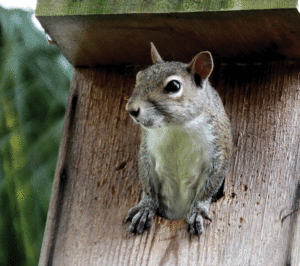Do you (and likely your dog) love watching the curious adventures of squirrels as they jump tree to tree and scurry around in your yard? 
While many people know that squirrels like acorns and have bushy tails, what else are the crazy critters up to as they bark, squeal, purr and squeak around the tree tops?
While there are more than 280 species of squirrels in the world, in Maryland, you’ll only see a handful of them.
The most common being the gray squirrel (which can actually be black, white or blonde), the southern flying squirrel, and the eastern fox squirrel.
Red squirrels are also in the state, however, they live in the slopes of western Maryland and, so far, have yet to have migrated to the Eastern Shore.
Meanwhile, the Delmarva Fox Squirrel stays primarily on the Eastern Shore and into Pennsylvania.
After significant efforts and intervention, the Delmarva fox squirrel was officially taken off of the
Threatened and Endangered list in 2015 after being listed since 1967.
Nuts
As squirrels prepare for the colder weather, they dart about and will eventually create hundreds of caches of food, most of which are only a quarter of an inch underground but which can be up to a foot down.
So do they actually remember where they hid the nuts?
Studies show that they do recover about 85 percent of the buried treasure, while a few of the discards may end up germinating into a new tree.
The critters use their sense of smell to help them locate the caches.
A gray squirrel can sniff out buried nuts under a foot of snow and will tunnel into the flakes to help them get closer to the scent.
For animals not more than a few pounds themselves, they’ll eat a staggering average of one and a half pounds a week.
Functional Body
If you’ve ever had a squirrel get alarmingly close to you in a parking lot, you may have noticed a few features beyond their fluffy tail.
That fluffy tail, by the way, is used for everything from balance to shade to a communication device.
It allows them to steer when swimming (yep, they can swim, and quite well, too) or helps them scare off predators when they puff it up.
Squirrels have paws that are hand-like, and they are one of few animals that have little thumbs and strong claws that help them climb head first down trees or grasp onto nuts.
They can also rotate their hind feet 180 degrees and even have whiskers on their legs as well as their face, which help them gauge if a hiding spot is too tight.
Their acrobatics are likely even more impressive than you (or your dog) even thought.
They can leap between objects that are 10 feet apart and can sprint vertically up a tree at 12 miles per hour.
Something not quite as endearing you may have noticed in an up close encounter are the squirrel’s incisors.
Like a beaver, squirrels have large orange front teeth and keep growing the squirrel’s entire lifetime.
While they need them to eat several hard items in their diet, it can also lead to severe dental problems such as when their top and bottom teeth won’t line up correctly causing them to drool excessively, be unable to close their mouths, or even lead to difficulty eating.
Before walking briskly away with your purse slightly poised to take a swing, take a peek next time.
Making a Home for Squirrels (Before they Invade Yours)
Aside from mice and relatives, one of the worst houseguests you can have is a squirrel.
Often, they’ll sneak in through ventilation and vents and curl up in your cushy insulation.
As mentioned previously, they have continuously growing teeth and to curb the problem, squirrels will actually gnaw on support beams and walls.
And of course, they probably won’t use the guest restroom.
One way to combat the issue is to provide nesting boxes for them.
Plain, unpainted boxes hung 25 to 30 feet high on trees that are at least 10 inches are just right.
The boxes will attract the mother squirrels, who mate twice a year; once in December to February and then again in May to June, and usually have about two to six babies at a time.
Hairless and toothless, they are a face only a mother could love and love she does, as mother squirrels are particularly aggressive towards animal threats.
While it was once reported a mother squirrel attacked and killed a Rottweiler in Russia, a mother squirrel also has a soft spot and will adopt orphaned or abandoned babies she finds.
There’s no need to make the boxes too fancy — add a little perch if you’d like and throw some dried leaves in for bedding, making sure to drill a few holes in the bottom for drainage.
Don’t worry about having a water source around either — most of their thirst is quenched by dew and the plant material in their diet.
If they don’t get into your home, you may still find them being bothersome to the bulbs in your gardens.
To prevent bulb snatching, put a layer of chicken wire in the dirt over top of your bulbs so your flowers can grow without pesky little squirrel paws digging them up.
“Chicken of the Trees”
Perhaps you’ve been watching survival shows on TV or your kid got a BB gun for Christmas and now you find yourself wondering, “What’s it like to eat a squirrel?”
Well, some call it the “chicken of the trees,” and while there isn’t much to eat, there are some good pockets of meat in the back and the hind legs.
The easiest cooking method several of us use for questionable gamey meats is to throw it in a crockpot with some veggies for squirrel stew, and it works pretty nicely.
Another tried and true method for when in doubt is to cut it up and deep fry for some squirrel nuggets.
Many folks also choose to use it interchangeably in recipes that call for rabbit.




